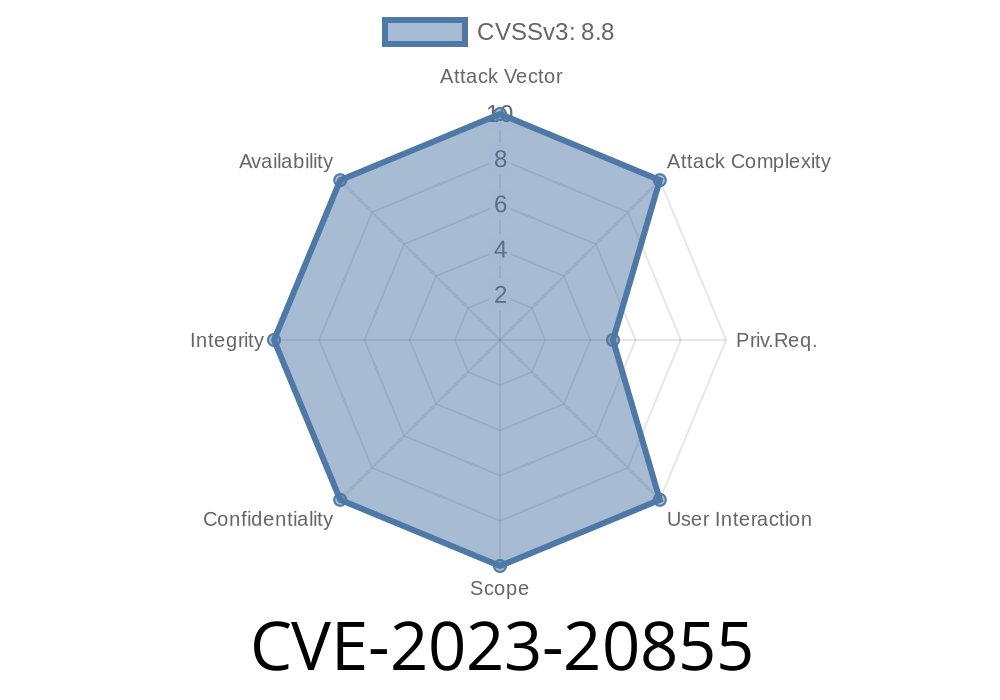In the world of cybersecurity, new vulnerabilities are discovered frequently. One such vulnerability has been found in VMware's vRealize Orchestrator platform. The software contains an XML External Entity (XXE) vulnerability, which could potentially be exploited to access sensitive information or escalate privileges by certain threat actors with non-administrative access to the platform. In this post, we will dive into the details of this vulnerability (CVE-2023-20855), provide code snippets of the exploit, and offer mitigation strategies. We will also point you to original references for further reading.
CVE-2023-20855 Details
The vulnerability (CVE-2023-20855) pertains to the vRealize Orchestrator, an automation platform by VMware that streamlines the automation of complex IT workflows. An XXE vulnerability exists in the XML parsing functionality of the software. Threat actors can exploit this vulnerability by introducing a custom XML input that bypasses the imposed parsing restrictions.
The potential outcomes of a successful XXE exploitation include unauthorized access to sensitive data, execution of arbitrary code, and/or possible escalation of privileges—allowing the attacker to gain greater control over the targeted system.
A code snippet of the malicious input that could be used to exploit this vulnerability is as follows
<!DOCTYPE foo [
<!ELEMENT foo ANY >
<!ENTITY xxe SYSTEM "file:///etc/passwd" >]>
<foo>&xxe;</foo>
In this example, the malicious input is an XML document which defines an external entity "xxe." The external entity references a local file ("/etc/passwd"), commonly found on Unix-based systems and containing user account information. The XML document uses "&xxe;" to include the content of the external entity within the "foo" element. If successfully parsed by the vulnerable vRealize Orchestrator system, this input would expose the contents of the "/etc/passwd" file to the attacker.
Mitigation Strategies
To mitigate the impact of this vulnerability, organizations using VMware vRealize Orchestrator should take the following steps:
1. Apply the relevant patches released by VMware. Reference the official VMware Security Advisory for CVE-2023-20855 to determine which patch version is applicable to your environment.
2. Restrict access to the vRealize Orchestrator platform, ensuring that only trusted users are granted access.
3. Monitor logs and network activity for any unusual or suspicious behavior that could indicate exploitation attempts.
4. Consider implementing network security measures, such as Intrusion Prevention Systems (IPS), to proactively protect against potential attacks.
Original References
For more details on this vulnerability and its mitigation, we recommend reviewing the following official resources:
- CVE-2023-20855 Entry on the NIST National Vulnerability Database (NVD)
- VMware Security Advisory VMSA-2023-####
- VMware vRealize Orchestrator Documentation
Conclusion
The discovery of the CVE-2023-20855 XXE vulnerability highlights the importance of maintaining software security best practices and staying up-to-date on emerging threats. Organizations utilizing VMware vRealize Orchestrator should take the necessary precautions to ensure the safety and integrity of their systems. Patching affected software, restricting access, and implementing additional security measures can help mitigate the potential risks associated with this vulnerability.
Timeline
Published on: 02/22/2023 00:15:00 UTC
Last modified on: 03/03/2023 14:04:00 UTC
